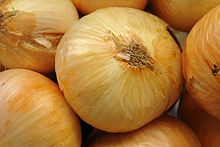Isoalliin
| Structural formula | |||||||||||||
|---|---|---|---|---|---|---|---|---|---|---|---|---|---|

|
|||||||||||||
| General | |||||||||||||
| Surname | Isoalliin | ||||||||||||
| other names |
|
||||||||||||
| Molecular formula | C 6 H 11 NO 3 S | ||||||||||||
| External identifiers / databases | |||||||||||||
|
|||||||||||||
| properties | |||||||||||||
| Molar mass | 177,22 g · mol -1 | ||||||||||||
| Physical state |
firmly |
||||||||||||
| Melting point |
153 ° C |
||||||||||||
| solubility | |||||||||||||
| safety instructions | |||||||||||||
|
|||||||||||||
| As far as possible and customary, SI units are used. Unless otherwise noted, the data given apply to standard conditions . | |||||||||||||
Isoalliin is a sulfur-containing ingredient of the onion ( Allium cepa ), to which the typical odor and tear irritation, e.g. B. when cutting an onion, are due. It is the double bond isomer of the alliin present in garlic ( Allium sativum ) . Although structurally very similar to the alliin, isoalliin reacts completely differently. For predators in the animal kingdom and also for pathogens in plants, it is likely to be a defense substance.
Reaction of isoalliin and its derivatives
In the onion, isoalliin is stable and does not irritate tears, but comes into direct contact with the enzyme alliinase in the event of injuries, for example through eating by pests or processing for food, and reacts to various, in turn very reactive compounds, see scheme below. This start reaction can be prevented by low temperatures; isoalliin can therefore only be isolated by extraction from the onion at temperatures below 0 ° C, e.g. B. in ethanol . Since the molecule has two chiral centers (on the sulfur atom and on the carbon atom with the amino group ), there are four stereoisomers of isoalliin. Only the one mentioned above is found in the onion and can be broken down by Alliinase.
If the onion injured arises from Isoalliin in the first step by cleavage of the Alaninfragmentes by the alliinase and the enzyme co-factor pyridoxal phosphate , the 1-Propensulfensäure represented by tautomeric (engl. Hydrogen rearrangement to the so-called lachrymatory factor lacrimatory factor, LF ), the Propanthial- S -oxide in two isomeric forms ( syn– and anti - ), with the syn form being the main product. This is why isoalliin itself is also referred to as lacrimatory precursor (often also lachrymatory p. ) In English . The split off alanine fragment breaks down into pyruvate and ammonia . The tear-irritating factor itself is very reactive, can hydrolyze to propionaldehyde , sulfuric acid and hydrogen sulfide , but it can also enter into cycloadditions with itself to form four- and five-membered rings. At the higher temperatures of steam distillation at 100 ° C and of course when boiling or frying, dipropyl disulfide is formed in addition to propionaldehyde . The latter represents the saturated and reduced (oxygen-free) form of allicin , which can be extracted from garlic. Here it becomes clear how closely the bulbous plants A. sativum and A. cepa are also "chemically" related to one another.
Occurrence
Alliin and isoalliin are largely mutually exclusive within the allium species. Garlic varieties contain little or no isoalliin. Conversely, the same applies to alliin in many other edible onions and leeks. The content of isoalliin in different bulb plants varies between about 100 and 900 mg / kg ( ppm ) fresh produce. Onion species in which isoalliin has been detected in significant quantities:
- Altai onion ( A. altaicum )
- Gold sea onion ( A. altyncolicum )
- Shallot ( A. ascalonicum )
- Onion ( A. cepa in various varieties)
- Nodding leek ( A. nutans )
- Leeks ( A. porrum )
- Chives ( A. schoenoprasum )
- Winter onion , winter hedge ( A. fistulosum )
Alliin-containing allium species that contain little or no isoalliin:
- Vegetable garlic ( A. ampeloprasum )
- Garlic-Chives , Japanese Spring Onions, Rakkyo ( A. chinense )
- Wild garlic ( A. longicuspis )
- Garlic ( A. sativum )
- Wild garlic ( A. ursinum )
- Allermann's harness ( A. victorialis )
See also
Individual evidence
- ^ Database Natural Products CD-ROM ver 15: 1, 1982–2007, Chapman & Hall.
- ↑ Eric Block: The Chemistry of Onion and Garlic. Spectrum of Science , 05/1985, 66-71.
- ↑ This substance has either not yet been classified with regard to its hazardousness or a reliable and citable source has not yet been found.
literature
- Eric Block: Garlic and Other Alliums: The Lore and the Science . Royal Society of Chemistry, Cambridge 2010, ISBN 978-0-854-04190-9 ( limited preview in Google book search).
- Eric Block: The organosulfur chemistry of the genus Allium and its importance for the organic chemistry of sulfur. Angewandte Chemie , 1992 , 104 , 1158-1203 doi : 10.1002 / anie.19921040906
- Eric Block: The Chemistry of Onion and Garlic. Spectrum of Science , 05/1985, 66-71
- Roman Kubec, Markéta Svobodová, Jan Velíšek: S-Alk (en) ylcysteine Sulfoxides in Some Allium Species. Identification of a New Flavor Precursor: S-Ethylcysteine Sulphoxide (Ethiin). In: Journal of Agricultural and Food Chemistry. 48, 2000, p. 428, doi : 10.1021 / jf990938f .


